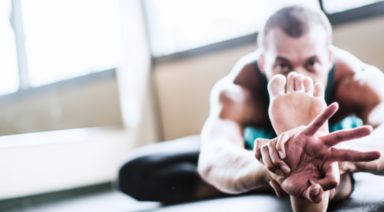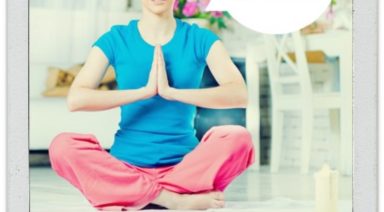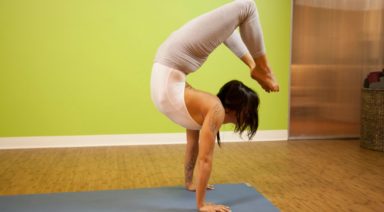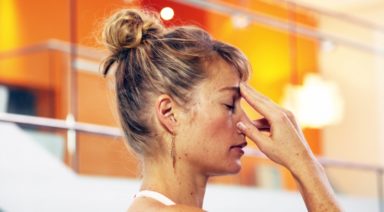Agnistambhasana: Firelog Pose

ADJUSTMENTS | BENEFITS | SEQUENCING | SANSKRIT | STEPS
Agnistambhasana (AG-nee-stahm-BAHS-ah-nah) is sometimes referred to as double pigeon pose because the legs take a similar shape as they do in pigeon pose. Firelog pose creates a deep stretch in the outer hips and space in the low back.
Philosophy + Origin
Fire (agni) is a transformative element. Agnistambhasana can be very uncomfortable as many people carry deep tension in their hips. See if you can feel the fire building in your hips and with your breath as you hold this pose.
ADJUSTMENTS/MODIFICATIONS:
- Sit on a folded blanket or block to create more space for your hips.
- Place your top leg in front of your bottom leg (rather than on top of it) to ease pressure on the knees.
- Use a block under your top ankle to release pressure on your bottom leg.
- Use a block under your top knee to help the hip relax and to relieve discomfort in the knee.
STEP-BY-STEP:
- Sit cross-legged with your right shin in front of your left.
- Shift your shins forward so they are about parallel with your mat.
- Flex your feet and scootch the soles of your feet closer to the edges of your mat, so your right ankle is about under your left knee, and your left ankle is about under your right knee.
- Use your hands to help lift your right shin on top of your left shin, right ankle on top of your left knee.
- Sit up tall or start to hinge forward at your hips. If folding forward, walk your hands out on the ground in front of you.
- Hold for up to a minute, then return to a neutral seat. Repeat on the other side.
PREPARATORY POSES:
- Bound angle pose | Baddha konasana
- Easy pose | Sukhasana
- Supine figure four
SEQUENTIAL POSES:
- Lotus pose | Padmasana
- Long horn pose | Dirghasrngasana
- Cow face pose | Gomukhasana
COUNTER POSES:
- Bharadvaja’s twist I | Bharadvajasana I
- Seated forward fold | Paschimottanasana
- Bridge pose | Setu bandha sarvangasana
SANSKRIT:
- Agni = fire
- Stambha = logs
- Asana = pose
BENEFITS:
- Stretches the outer hips.
- Thought to release tension in mind and body.
- Thought to build digestive fire.
Legal Disclaimer Before participating in any exercise program or using any fitness products or services that may be described and/or made accessible in or through the Gaia Website and/or the Services, you should consult with a physician or other healthcare provider. Read more about Gaia’s Terms Of Use.
Ardha Uttanasana: Half Standing Forward Bend

ADJUSTMENTS | BENEFITS | SEQUENCING | SANSKRIT | STEPS
An effective stretch for your hamstrings and calves ardha uttanasana (ARE-dah OOT-tan-AHS-anna), is often used during vinyasa sequences to connect the breath as you flow from one posture to the next.
Philosophy + Origin
One of the reasons ardha uttanasana is used so much in vinyasa yoga classes is that it positions the body for chaturanga dandasana. Because it engages the navel and core, it’s a powerful pose for warming up the body, which is why it’s included in warm-up sequences. Despite its sometimes transitory nature, the pose also engages the navel chakra (manipura), which can bring the practitioner increased confidence and willpower.





































